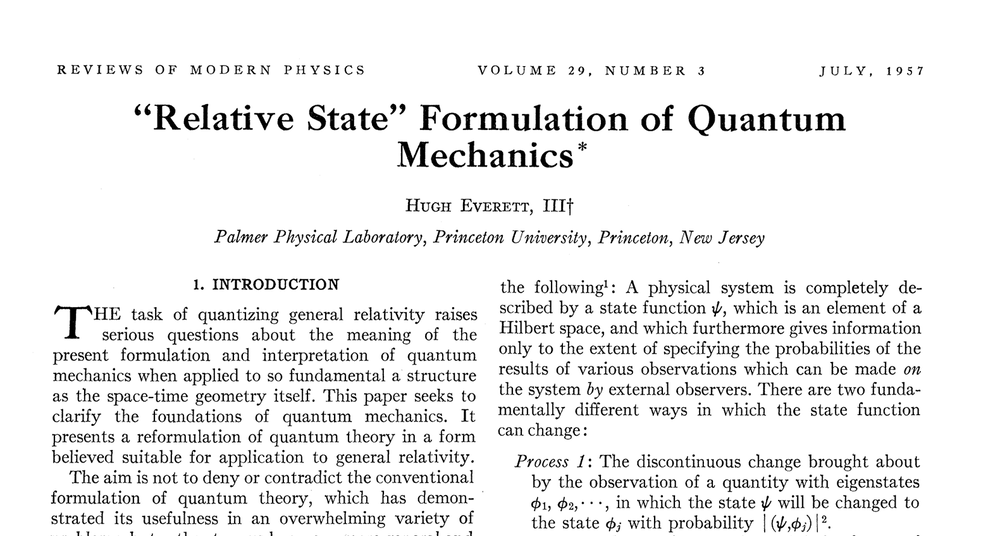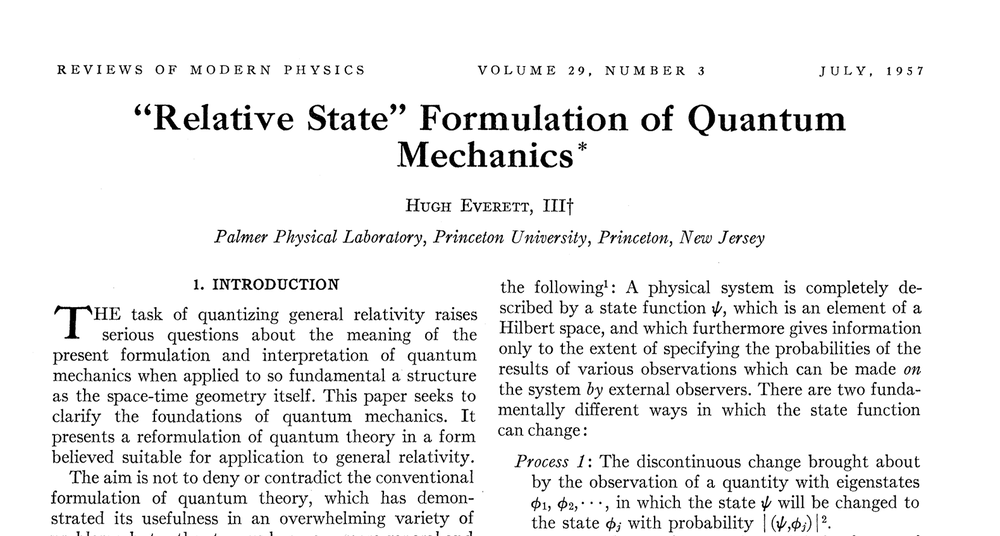Quantum Milestones, 1957: Sprouting Parallel Universes
For the International Year of Quantum Science and Technology, we are covering the history of quantum physics.
Quantum physics has often stretched the imagination with concepts such as wave–particle duality and entanglement. But perhaps no stretch has gone so far as the many-worlds interpretation, which states that measuring a quantum object produces separate universes for each possible outcome. In 1957, Hugh Everett, a Princeton University graduate student, proposed this theory as a way to deal with apparent paradoxes surrounding quantum measurements [1]. Although the idea is not testable in the lab, it has influenced the thinking of many physicists and made several appearances in popular culture.
At the time that Everett was writing, the accepted explanation of quantum mechanics was the Copenhagen interpretation, which remains the conventional understanding. This interpretation starts with the wave function—a mathematical entity that describes the probability that a quantum object (or system) will be found in a particular state. A simple example is a photon traveling to the right and hitting a 50/50 mirror. The resulting wave function can be imagined as two traveling ripples—one on the right propagating beyond the mirror and one on the left reflecting backward. If a scientist named Alice places a detector on the right side of the mirror, there’s a 50% chance the photon will hit the detector, and she’ll hear a click.
What troubled Everett (and other physicists [2]) was how a measurement affects the wave function. According to the Copenhagen interpretation, an observer makes a measurement, and the wave function suddenly collapses to the observed state. So when Alice hears a click, the photon instantly consolidates on the right, while the ripple on the left disappears. Everett saw a problem in this discontinuous evolution and in its reliance on an external observer to initiate it.
Everett’s proposition was to assume that the wave function never collapses; it changes continuously. But then the question becomes: Why does the observer only see one outcome? Everett’s explanation was that the overall system (observer plus object) splits, or “branches,” into a superposition of states, leading to multiple trajectories. It’s as if one Alice takes the “click” trajectory, and another Alice takes the “no-click” trajectory. “Everett showed that if you interact with a quantum object, you enter into the superposition yourself,” says philosopher of physics Simon Saunders from the University of Oxford, UK.
This idea of multiple “yous” branching off and living different lives has been a recurring theme in movies, such as Dr. Strange and Everything Everywhere All at Once. In these popular representations, a person can hop between different universes. But Everett’s model does not allow branches to affect each other. “No observer will ever be aware of any ‘splitting’ process,” he wrote [1].
Prior to Everett’s work, other physicists, including Erwin Schrödinger, considered how the wave function could be understood in terms of a superposition of observers. But “Everett was the first who was bold enough to put it in such a clear and direct way and to propose it as a way to solve the quantum measurement problem,” says Philipp Strasberg, a theoretical physicist from the Autonomous University of Barcelona in Spain.
Everett’s solution did not attract many supporters in the beginning, Saunders says. One reason had to do with explaining probability in measurement outcomes. Naively, one could imagine that the likelihood of a particular observation, such as Alice’s click, is imprinted in the number of branches in which that observation occurs, relative to the total number of branches. However, theorists showed in the 1970s that this naive “branch counting” would lead to incorrect measurement statistics. To avoid this pitfall, researchers have devised more sophisticated branching scenarios, Saunders says, but understanding probability remains a difficulty for many-worlds theories.
Despite that difficulty, the many-worlds interpretation has had a broad scientific impact. It was promoted early on by gravity theorist Bryce DeWitt, then at the University of North Carolina, Chapel Hill, who coined the term “many worlds.” It was also championed by quantum-computing pioneer David Deutsch of the University of Oxford, who likened the parallel computations in a quantum computer to parallel worlds. The theory provided a conceptual basis for some theories in cosmology, and it may prove useful in attempts to bridge quantum physics with gravity (see Viewpoint: Can Classical Worlds Emerge from Parallel Quantum Universes?). “It significantly influences the kind of unified theory of quantum gravity for which we are searching,” Strasberg says.
The many-worlds interpretation has many detractors, but “it’s become less and less on the fringe, and more and more physicists have been willing to come out and support it,” says Saunders, who edited and contributed to a collection of essays on many-worlds theories [3]. He thinks the reason for this growing acceptance is that the alternatives, such as Bohmian mechanics and dynamical-collapse theory, have trouble dealing with relativity or are unwieldy to calculate with. When straw polls are conducted at conferences on quantum foundations, about a third to a half of the participants will put up their hand in favor of many worlds, Saunders says. Strasberg agrees: “Among those who have seriously thought about the quantum measurement problem, I wouldn’t be surprised to find that the many-worlds interpretation ranks number one.”
“Still, not many are prepared to be out-front about it,” Saunders says. He thinks that researchers are reluctant to show an openness to such a seemingly crazy idea. Strasberg has a different take: “I think all interpretations of quantum mechanics have a weird element, and which one you find more weird seems to be influenced more by personal tastes than by scientific arguments.”
–Michael Schirber
Michael Schirber is a Corresponding Editor for Physics Magazine based in Lyon, France.
References
- H. Everett, III, “‘Relative state’ formulation of quantum mechanics,” Rev. Mod. Phys. 29, 454 (1957).
- S. Weinberg, “The trouble with quantum mechanics,” The New York Review of Books Jan. 19 (2017), https://www.nybooks.com/articles/2017/01/19/trouble-with-quantum-mechanics/.
- Many Worlds? Everett, Quantum Theory, and Reality, edited by S. Saunders et al. (Oxford University Press, Oxford, 2012)[Amazon][WorldCat].







